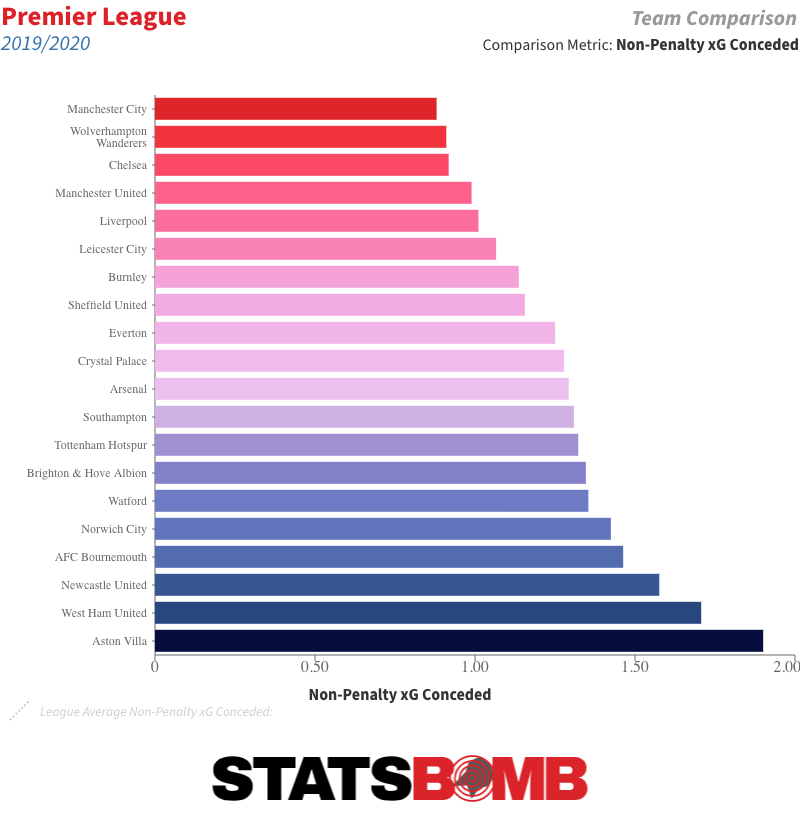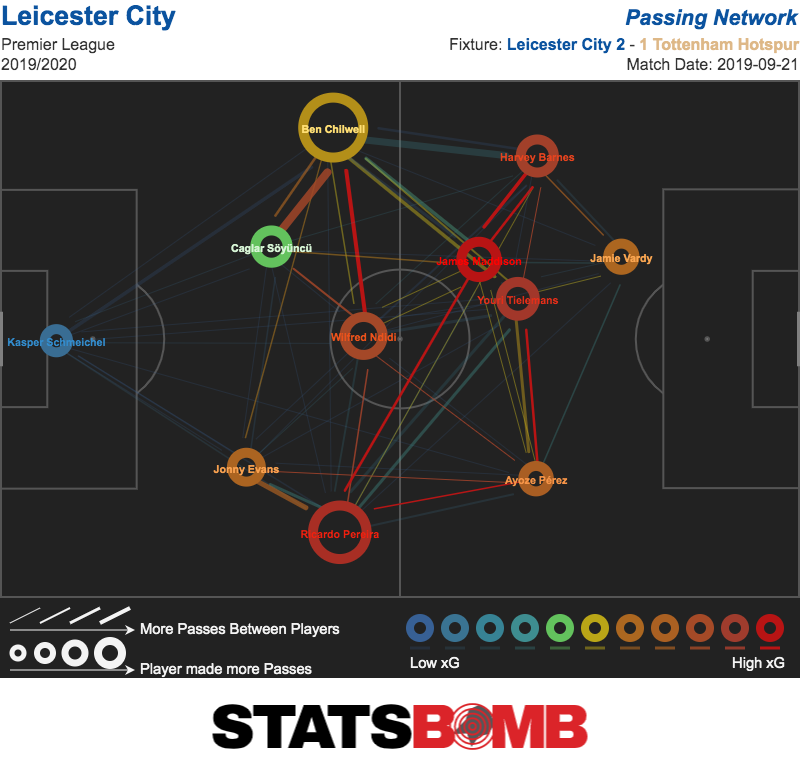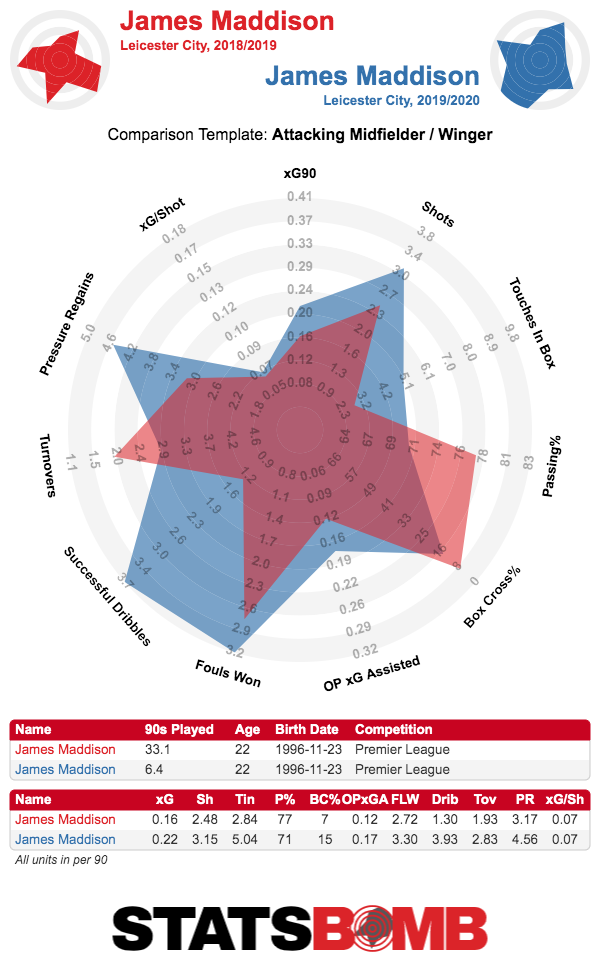If any football club knows about breaking the hegemony of the top sides, it’s Leicester. Cast your minds back to the ancient days of summer 2019. Things were simpler back then. The days were longer. The weather was warmer. There was a consensus about an emerging “chasing pack” of teams capable of challenging the Premier League’s top six. Wolves, Everton, Leicester and West Ham were all seen as having a real chance of breaking in. Some even put Watford among that group. Cut to late September and we’ve seen some differences in fortunes. Wolves and Watford sit at 19th and 20th in the table. They’re both capable of turning things, but a midtable finish would look like a positive right now. Everton also look like they can shake off some early season rust, but it does seem as though there are concerns in that side. West Ham find themselves with an impressive 11 points, but there are concerns in the numbers. Their 10.70 expected goals conceded is the second worst in the division, while 7.51 xG on the attacking side is only league average. The Hammers should be pleased with their start, but it feels like their midfield solidity questions have not been answered satisfactorily. So that leaves us with Leicester. The Foxes find themselves third in the table and the thing to note is that they haven’t had a gentle schedule. The club have already faced three of the “official” top six, with a very reasonable four points from those games. A tough start to the season obviously necessitates a more defensive minded approach, and Leicester have defended very well so far. Things have gone their way a touch, but their 5.35 xG conceded is currently the fourth best in the league.  Of course, there have been payoffs at the other end, with Leicester’s 6.46 xG on the attacking side looking below average, though this has a chance to shift when the fixture list eases up.
Of course, there have been payoffs at the other end, with Leicester’s 6.46 xG on the attacking side looking below average, though this has a chance to shift when the fixture list eases up.  This feels like a conscious choice on the part of manager Brendan Rodgers. While the image of the Northern Irishman for many is of the high scoring, high conceding Liverpool side of 2013/14, he is ultimately a chameleon, borrowing tactics from elsewhere and implementing them quickly before other sides catch on and find solutions. While much of Leicester’s most exciting football has come with James Maddison and Youri Tielemans playing in front of Wilfried Ndidi in a midfield three, Rodgers has opted to shift Maddison wide this year and add the extra solidity of Hamza Choudhury for four of this year’s six games. Choudhury is a solid defender, but his threat on the ball remains extremely limited and he thus mostly opts to simply recycle possession.
This feels like a conscious choice on the part of manager Brendan Rodgers. While the image of the Northern Irishman for many is of the high scoring, high conceding Liverpool side of 2013/14, he is ultimately a chameleon, borrowing tactics from elsewhere and implementing them quickly before other sides catch on and find solutions. While much of Leicester’s most exciting football has come with James Maddison and Youri Tielemans playing in front of Wilfried Ndidi in a midfield three, Rodgers has opted to shift Maddison wide this year and add the extra solidity of Hamza Choudhury for four of this year’s six games. Choudhury is a solid defender, but his threat on the ball remains extremely limited and he thus mostly opts to simply recycle possession.  Rodgers’ solution to this has been to instruct Choudhury to move to a left sided role while in possession, with Maddison moving in to become a number ten. This obviously allows Maddison to become much more involved in the attacking phase while minimising the number of times Choudhury has to touch the ball. The passmap against Manchester United shows it well, with Choudhury taking touches in much wider areas despite nominally playing a more central role than Maddison.
Rodgers’ solution to this has been to instruct Choudhury to move to a left sided role while in possession, with Maddison moving in to become a number ten. This obviously allows Maddison to become much more involved in the attacking phase while minimising the number of times Choudhury has to touch the ball. The passmap against Manchester United shows it well, with Choudhury taking touches in much wider areas despite nominally playing a more central role than Maddison.  It’s not obvious whether this fixes the problem or simply moves it around. Yes, it ensures Maddison is the most involved creator, but it means Leicester essentially sacrifice any attacking threat from a left winger to do so. When Maddison or Tielemans receive the ball as the team is attacking, they now only have two obvious outlets making runs into the box: Jamie Vardy or whoever is playing on the right wing. In terms of Vardy, the past year or so has shown him continue to defy father time and produce a good volume of shots in dangerous locations. That hasn’t happened as much this year (his xG per 90 is an underwhelming 0.25), but it can perhaps be excused due to Leicester’s generally defensive approach. When looking at his shot map, the thing that stands out is just how many of his chances are still from through balls. It would be hard to do that if he had physically declined in a big way.
It’s not obvious whether this fixes the problem or simply moves it around. Yes, it ensures Maddison is the most involved creator, but it means Leicester essentially sacrifice any attacking threat from a left winger to do so. When Maddison or Tielemans receive the ball as the team is attacking, they now only have two obvious outlets making runs into the box: Jamie Vardy or whoever is playing on the right wing. In terms of Vardy, the past year or so has shown him continue to defy father time and produce a good volume of shots in dangerous locations. That hasn’t happened as much this year (his xG per 90 is an underwhelming 0.25), but it can perhaps be excused due to Leicester’s generally defensive approach. When looking at his shot map, the thing that stands out is just how many of his chances are still from through balls. It would be hard to do that if he had physically declined in a big way.  And Leicester need him to make those runs to receive through balls, because they’re not getting a lot from the right. Ayoze Perez has been played there most frequently, and it’s fair to say he’s not interpreting the role in the most exciting way. He’s taken all of five shots so far for just 0.3 expected goals, but you can’t say he’s not working hard. It takes the midfield radar to show just how much effort he’s putting in on the defensive side:
And Leicester need him to make those runs to receive through balls, because they’re not getting a lot from the right. Ayoze Perez has been played there most frequently, and it’s fair to say he’s not interpreting the role in the most exciting way. He’s taken all of five shots so far for just 0.3 expected goals, but you can’t say he’s not working hard. It takes the midfield radar to show just how much effort he’s putting in on the defensive side:  For whatever reason, Rodgers made the decision to concentrate on defensive stoutness in the opening part of the season. But some hope has come recently for a more progressive football. Leicester returned to starting Maddison and Tielemans as free eights in the win against Tottenham, with Harvey Barnes and Perez wide. The passmap below shows how willing Maddison and Tielemans were to push up, making it a genuine 4-1-4-1 in possession.
For whatever reason, Rodgers made the decision to concentrate on defensive stoutness in the opening part of the season. But some hope has come recently for a more progressive football. Leicester returned to starting Maddison and Tielemans as free eights in the win against Tottenham, with Harvey Barnes and Perez wide. The passmap below shows how willing Maddison and Tielemans were to push up, making it a genuine 4-1-4-1 in possession.  That Rodgers was willing to role this out against a “big” team like Tottenham shows a bravery that has been lacking previously this season. That it worked should hopefully encourage him to do it again. The Tielemans/Maddison axis has been a real positive of Rodgers’ time at the King Power Stadium, and it would be frustrating to see Choudhury continually shoehorned in. Maddison in particular looks like he’s on the cusp of a breakout season. There are still questions about his tactical role, and it feels like Rodgers is more likely to encourage him to flourish than try to teach him a stricter positional understanding. This could hurt him later in his career (see: Coutinho, Philippe), but for now, it’s hard to deny that he’s awfully exciting to watch in full flight. When looking at his profile compared to last season, it definitely seems like he's enjoying the freedom.
That Rodgers was willing to role this out against a “big” team like Tottenham shows a bravery that has been lacking previously this season. That it worked should hopefully encourage him to do it again. The Tielemans/Maddison axis has been a real positive of Rodgers’ time at the King Power Stadium, and it would be frustrating to see Choudhury continually shoehorned in. Maddison in particular looks like he’s on the cusp of a breakout season. There are still questions about his tactical role, and it feels like Rodgers is more likely to encourage him to flourish than try to teach him a stricter positional understanding. This could hurt him later in his career (see: Coutinho, Philippe), but for now, it’s hard to deny that he’s awfully exciting to watch in full flight. When looking at his profile compared to last season, it definitely seems like he's enjoying the freedom.  And the reason Leicester are able to compensate for Maddison’s chaotic nature, even when Choudhury isn’t on the pitch, is just how much work Ndidi manages to get through. He knows what his job is in this team. He does it. A lot. There’s not much more to it than that.
And the reason Leicester are able to compensate for Maddison’s chaotic nature, even when Choudhury isn’t on the pitch, is just how much work Ndidi manages to get through. He knows what his job is in this team. He does it. A lot. There’s not much more to it than that.  The biggest question for Leicester is whether Rodgers will trust Ndidi to just do his thing here. We haven’t seen a lot of new signing Dennis Praet yet, but it seems like the idea is for him to play the Choudhury role with a little more threat on the ball, and that would be a shame. On the attacking side of the ball, Leicester have the balance right with two central creators in Maddison and Tielemans, and two direct running wide players either side of Vardy. Swapping out a runner for a more patient central midfielder like Praet or Choudhury can make the side too slow in the build up, and lead to periods of stale possession. This is a fine option in certain situations, but shouldn’t be the primary tactic. Rodgers is a fidgety manager. Every time he seems to have settled on something, even something that’s working really well, he gets bored and changes it. He came up with a core shape straight away at the King Power, but has subsequently tweaked it to add more midfield solidity. It’s a strange tradeoff that seems to play against the strengths of the side. As the season goes on, he will certainly play around with the system some more, but this could be a positive for Leicester. He’s built himself a flexible squad of players who can fill a variety of roles, and it’s likely we’ll see all manner of formations this year. Rodgers’ methods tend to maximise players’ output for the first year or two before he starts to run out of solutions, so that would suggest this year is the window for Leicester. It would only take one of Manchester United, Arsenal, Chelsea or Tottenham to fail to solve any of their problems and have a poor season for a top six spot to really open up. That, combined with Leicester keeping it together, would be the recipe for a very successful season for the Foxes.
The biggest question for Leicester is whether Rodgers will trust Ndidi to just do his thing here. We haven’t seen a lot of new signing Dennis Praet yet, but it seems like the idea is for him to play the Choudhury role with a little more threat on the ball, and that would be a shame. On the attacking side of the ball, Leicester have the balance right with two central creators in Maddison and Tielemans, and two direct running wide players either side of Vardy. Swapping out a runner for a more patient central midfielder like Praet or Choudhury can make the side too slow in the build up, and lead to periods of stale possession. This is a fine option in certain situations, but shouldn’t be the primary tactic. Rodgers is a fidgety manager. Every time he seems to have settled on something, even something that’s working really well, he gets bored and changes it. He came up with a core shape straight away at the King Power, but has subsequently tweaked it to add more midfield solidity. It’s a strange tradeoff that seems to play against the strengths of the side. As the season goes on, he will certainly play around with the system some more, but this could be a positive for Leicester. He’s built himself a flexible squad of players who can fill a variety of roles, and it’s likely we’ll see all manner of formations this year. Rodgers’ methods tend to maximise players’ output for the first year or two before he starts to run out of solutions, so that would suggest this year is the window for Leicester. It would only take one of Manchester United, Arsenal, Chelsea or Tottenham to fail to solve any of their problems and have a poor season for a top six spot to really open up. That, combined with Leicester keeping it together, would be the recipe for a very successful season for the Foxes.
2019
Can Leicester City Gatecrash the Top Six Party?
By admin
|
September 25, 2019
